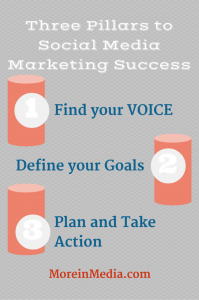
If we’ve said it once we’ve said it 100 times: content marketing is at the core of any inbound marketing strategy. (And if it isn’t yet for you, then it should be.)
What’s great about content is that it’s sort of an abstract word that can become tactile in a number of different ways–you can bring content to life through whichever format you think aligns best with your company’s goals and your audience’s preference.
The content format that’s nearly always a part of an effective strategy are blog posts. In general, the written word is the most efficient way to regularly share content related to your business and industry. Consistent blogging about topics relevant to your personas will make you stand out as an expert in the industry, and will turn you into a reliable source of information. Building that trust with prospects is what turns them into customers down the line. It’s also a great way to promote premium offers by sharing excerpts of your latest ebook, offering the next step in a given process, and including direct CTA’s to the offer. Further, it’s the best way to improve your SEO–each blog post is a new, unique page online, which increases the opportunities for keyword optimization, other sites linking to you, and having what to share on social media.
So in that vein, let’s focus on the best ways to create effective blog posts.
1) As with most of inbound marketing, you can’t start this process without having identified your target audience. Without this step, your article will be impersonal and ineffective. It will also make it harder to pick a topic for the blog post, which is the next step. As you get to know your personas and customers better, and continue to research their sphere and what their concerns are, the topics that are relevant to write about will become increasingly clear. It all comes back to understanding what’s being discussed, how that’s relevant to you as a company, and how that’s of interest to your personas and readers.
2) As mentioned, step 2 is picking a general topic or theme that will guide you in writing your post. Remember that no matter what your industry is, your blog topic won’t be boring if it’s answering questions your reader is asking.
Let’s pretend for a second that your company manufactures hospital scrubs. When researching your prospects, you’ll have come across some topics that are key for you to understand about the sphere your product lives in. Well, the content is where you educate your prospects on those topics.
Write a blog post about the importance of doctors and nurses working in comfortable attire that can be washed easily and frequently.
Write an article on what makes clothing sterile vs. not, anti-contaminant vs. not, hypoallergenic vs. not, etc.
Write a blog post summarizing the other key supplies in a doctor’s toolkit, like stethoscopes and surgical gloves, perhaps with a twist on which have stayed the same and which have changed over the years.
Create a series listing the precautions doctors take to avoid certain health concerns that arise in their profession.
Want to write something that veers a bit more to the human interest side of things?
Write about the history of surgical attire, compile pictures of the most out-there scrubs you can find, or list where/how scrubs can be used outside of a medical setting.
3) Once you know what theme you’re covering, you’ll want to turn it into a specific working title that narrows down that theme. Now, while this step is important to help you determine what specifically you’re focusing on, we at The Brand Builders find that we deviate from that suggestion once we finish writing the post. The blog post title is incredibly important, because it’s the first thing that will grab the reader’s attention.
The title should convey the value of the post, it should have a keyword in it, it should pop, and it shouldn’t be more than 60 characters. Those are a lot of factors to consider, that we find become more clear once the post has been written and we can see what we’ve covered, how our voice came across, and if there’s anything from the post that can be referenced in the title–for example, if we broke it down into 5 sections, the title can be “5 Ways We….”
4) Once you’ve chosen what to write about, you need to start the process of writing a dynamic post. That starts with the introduction. You need to grab the reader’s attention in the first few paragraphs, otherwise you’ll lose them before they’ve given the post a real chance. A few tips for a strong intro: include a story or a joke, add some interesting statistics or facts, or simply be empathetic, and demonstrate that you’re writing this for the reader’s benefit.
5) One key step that comes into the equation about now is research. Some writers prefer to do their research before they write the outline, and incorporate key points there. Others prefer to research as they write the piece. Either way, the point of putting this content out there is to communicate your expertise on this topic. You need to sound authoritative, your facts have to be right, and you need to be sharing information with your personas that they might not know.
6) So you have your topic, your template, and some relevant facts and figures. All that’s left to do is write! Expand on all of the points in your outline as needed, but don’t be afraid to deviate from it if you find that a point isn’t as relevant as previously thought, or there’s an aspect you now realize you want to include.
Don’t worry about the length of the post–5 different experts will give you 5 different opinions on what the ideal length of a blog post should be. Don’t add extraneous paragraphs because you think you need to hit a certain word quota, and don’t cut key points because you’re worried it’s too long–it should be as long as it needs to be to best convey the points you want to make.
An important thing to keep in mind when writing is that you want to develop a unique voice for yourself and, as an extension, your company. You want your readers to know that they are reading something that is authentically you. This goes back to the concept of thought leadership we’ve discussed several times on this blog; to help establish your presence online, you need to post in a way that resonates with your readers and makes them feel as though you’re talking directly to them.
This will depend a bit on who your personas are and what would resonate with them more. Would a more factual, serious style work, or would they appreciate some humor thrown in? Would they appreciate a point by point breakdown of everything you’re discussing, or would that make them feel like they’re being spoken down to? As you continue to write more pieces, you’ll better develop that organic voice that both reflects your brand’s personality and your persona’s goals.
7) As you’re writing, you need to be sure that the piece focuses on answering your consumers’ questions, as we’ve mentioned once or twice. But also remember that this article, as with every piece of text you put on your website, can be used to help prospects find you. To that vein, be sure to incorporate keywords throughout the piece to capitalize on the SEO opportunity. You have an opportunity to include a relevant keyword in the blog title, the article URL, the meta data, in the alt-text of the image you include, and of course, in the article itself. If possible, try not to use a keyword more than 5 times, or search engines might view it as spammy.
8) Once you’ve finished writing any piece of content, it requires an additional readthrough for editing and proofreading. We recommend having a separate set of eyes read it over, since you, or whoever writes the piece, might not realize the error or might make the same one again. The importance of this step cannot be stressed enough: if you post a piece full of spelling mistakes, or one that doesn’t flow organically, then nobody will take you seriously. It will weaken your credibility long-term, without a doubt. That’s why we never publish without at least 2 back-and-forths on a given piece, to be as sure as possible that we’ve caught anything we may previously have missed.
9) You should also optimize the post with formatting. That doesn’t just mean including a visually appealing image. That means breaking up large blocks of text with headers, subheaders, and/or lists. It means maintaining consistent style from post to post. It means using a font size that won’t require your readers to grab a magnifying glass. Have enough whitespace, which is just empty space around the paragraphs and between the paragraphs, so that readers can focus on the content. Bold or italicize important text and key takeaways that you want readers to remember.
10) The final step in creating a blog post is to include a CTA, a dynamic call-to-action that links to a premium offer. Try to reference an offer whose topic is related to the blog post, so that readers wanting to learn more about a given topic will be more inclined to click through. So for example, a blog post about other hypoallergenic clothing/ accessories that doctors can use (besides scrubs) might pair well with the ebook that delves into why hypoallergenic clothing is as important as anti-contaminant clothing in a medical environment. You can include the CTA at the bottom of the blog post, or, if your piece is on the longer side, try inserting it midway through
When you first start the content creation process, there’s definitely a learning curve. It’s something we notice when working with a new client–we need to understand what they like, any specific stylistic choices they prefer, if there are any topics that resonate more, etc. Over time we require less input from them as the voice and style choices become more defined and the client trusts our grasp of his preferences. The more you write, the more you’ll know how and what you like to write.
Digital & Social Articles on Business 2 Community
(88)
Report Post






